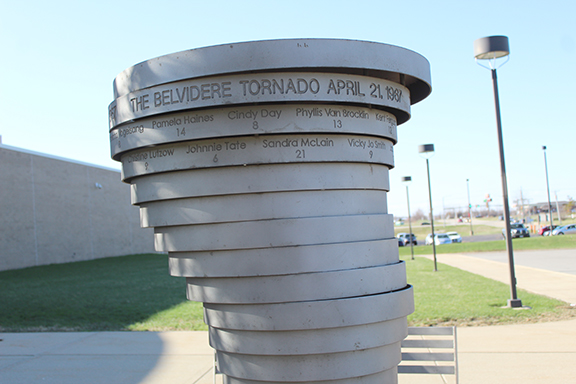Belvidere Tornado remembered
By Anne Eickstadt

ANNE EICKSTADT PHOTO Belvidere Republican
The Belvidere Tornado Memorial standing outside the Belvidere High School is a tribute to all those who lost their lives during the event. It is also a reminder of how everyone in the community pulled together to help each other during this disaster.
According to the National Weather Service, the winter of 1966-1967 had been a harsh, record-setting winter. The record 23-inch snowstorm of Jan. 26 and 27 led to Chicago’s snowiest winter, with a total of 68.4 inches. (The current record of 89.7 inches was set in 1978-1979).
There was continuous snow cover on the ground from Jan. 26 until March 9, a 42 day stretch. But the weather pattern had changed by late March and April. Spring had arrived. Chicago saw five straight days in the 70s the previous weekend—April 13 through 17. Rockford even hit 80 degrees during the mid-April warm spell. People in northeast Illinois were looking forward to another mild spring weekend Friday, April 21.
Friday morning, April 21, a strong west-southwest upper-level jet stream was in place from the southwest U.S. to the Great Lakes. At 500 millibars (about 18,000 feet) a short-wave trough was moving rapidly northeast from the southwestern U.S.
In response to the short wave, at the surface a wave of low pressure developed over the central Plains and moved northeast along a nearly stationary front which was draped across the Midwest. As the wave of low pressure approached northern Illinois, the stationary boundary surged north of Chicago as a warm front, bringing mild and humid air to the area.
Temperatures climbed into the low to mid 70s across north and central Illinois on strong south winds and dew point temperatures reached the lower 60s. As the wave of low pressure approached during the warmth of the afternoon, surface winds backed slightly to the south-southeast. This likely increased the low-level wind shear—the change of wind speed and direction with height—an important factor in producing rotating supercell thunderstorms and tornadoes. By late afternoon the mid-level short wave was approaching and the upper-level jet maximum of 120 knots (250 millibars or around 34, 000 feet) moved into the upper Great Lakes, which put northeast Illinois in the right-rear region of the jet—a favorable location for vertical development of thunderstorms.
This fatal combination of factors led to explosive development of rotating supercells along a line of storms that was moving across northern Illinois that afternoon. This line had already produced wind damage and tornadoes across Missouri, Iowa and northwest and north central Illinois. It would continue producing tornadoes across lower Michigan into the evening. But by far the most devastating tornadoes occurred in northeast Illinois and the Chicago area during the mid and late afternoon.
The Belvidere Tornado
The tornado first struck down at 3:50 p.m. 2 miles southeast of Cherry Valley. The tornado passed the Chrysler plant near I-90 where 300 new cars and 100 employee cars were destroyed. The tornado continued east-northeast through the southeast side of Belvidere. One hundred twenty-seven homes were destroyed, and hundreds more were damaged.
The most notable and horrific part of this tornado was the mayhem at the Belvidere High School. Buses had already picked up the elementary school children and were loading the high school students when the tornado struck. Twelve buses were rolled over. Students were flung like leaves into the muddy field. Thirteen of the 24 fatalities and 300 of the 500 injuries in this tornado occurred at the high school.
According to Tom Grazulis of The Tornado Project, this was the nation’s sixth worst school death toll from a tornado. The tornado ended in McHenry County, about two miles north of Woodstock.
1967 Tornado Disaster Monument
A stainless steel tornado, over 6 feet tall, is engraved with the names of all 24 people who were killed by an F4 tornado on April 21, 1967.
In 2007 Belvidere constructed a memorial for the victims of the 1967 tornado outside of the high school. The statue has 25 rings representing the 24 victims and everyone who was affected by that day.
Grazulis lists this event as a tornado family in his book “Significant Tornadoes.”
Thirteen were killed at Belvidere High School. The tornado moved into the bus loading areas as the students were being dismissed. 12 buses were overturned or thrown. A bus driver was killed. Most of the dead were students who were “tossed like leaves” into adjacent fields. Students and teachers used school doors and plywood from nearby homes as stretchers for the injured, carrying them into the school.
There was near-F4 damage to homes adjacent to the school. 300 new cars and 100 employee cars at the Chrysler Plant were destroyed. 130 homes were destroyed, 370 damaged. A marriage certificate from Belvidere was found south of Milwaukee, Wis. South of Harvard, a school bus was ripped in half and thrown into power lines as the driver and 20 students hid in a ditch.
In honor of their memory, here is a list of those who were killed:
Michael Bates, 6; Cindy Day, 9; Lawrence Decker, 17; Cecelia Eakin, 83; Kent Ferguson, 12; Harold Gustafson, 72; Pamela Haines, 14; Mary Jean Hamre, 65; Craig Hyser, 8; Barbara Johnson, 10; Gilbert Julin, 63; Bruce Lindley, 13; Cristine Lutzow, 9; Sandra McLain, 21; Theodore Nelson, 15; David Wayne Poe, 13; Dwight David Shaw, 11; Timothy Smith, 17; Vicky Jo Smith, 9; Jack Stoll, 23; Johnnie Tate, 6; Phyllis Van Brocklin, 13; Rebecca Vogelslang, 8; Norine Wych, 81.


